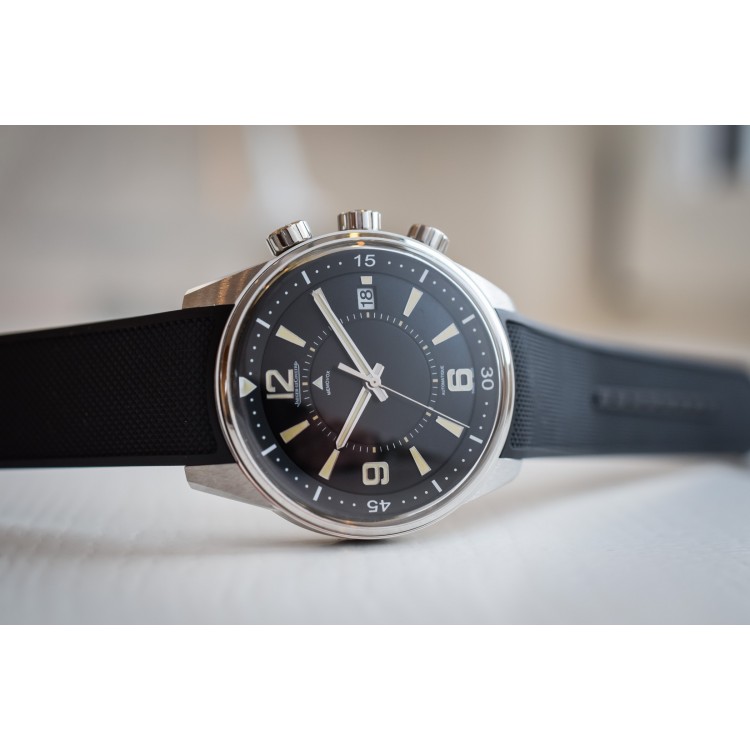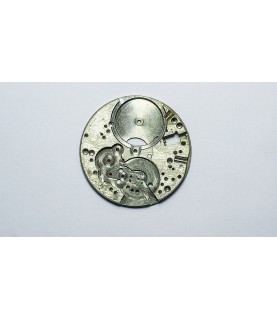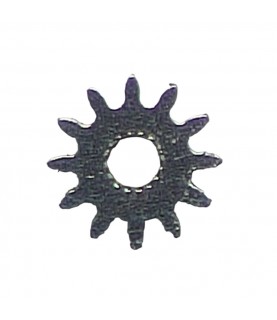Jaeger-LeCoultre Polaris Collection - The Spirit of '68

Released in January at SIHH, the Jaeger-LeCoultre Polaris Collection revives an iconic model to serve as the tentpole for a renewed focus on the sports-luxury segment. To students of horological history, the year 1968 was particularly significant in the world of Swiss watches. Although the quartz crisis was looming in the near future, the industry was still flourishing and filled with compelling introductions. One such innovation was Jaeger-LeCoultre's now-famous Memovox Polaris, a diving watch with a mechanical alarm. The 50th anniversary of that original timepiece is the inspiration for the Swiss brand's focus in 2018: the new Polaris collection, comprised of six sporty new models. If you read the June 2018 issue of WatchTime, there's a good chance you saw our interview with Lionel Favre, the Product Design Director for Jaeger-LeCoultre ("How a Classic Becomes a Collection"). In that conversation, he discussed the challenge of "identifying the spirit of the Polaris, through its codes and history" and transporting them into a new collection that features a variety of complications. For example, when you translate the Memovox Polaris design with its distinctive alarm functionality to a utilitarian chronograph, you lose part of what made the 1968 model so recognizable. What Favre and his team did to counteract that is simple. They standardized the dial architecture throughout the collection, making it identifiable and still in touch with the brand's aesthetic history. Meaning, you'll see the same three concentric circles, the same style flange, the same trapezoidal hour indexes and the same applied Arabic numerals in each timepiece in the Polaris line. Recently, we had the chance to spend an extended time with what we thought were the two most exciting new models: the headlining Polaris Memovox Limited Edition and its Chronograph complement. Here are our final thoughts. Polaris Memovox Alarm watches are unique in the watch world. Even in an industry governed by idiosyncratic tastes, alarm watches often remain on the horological periphery for many enthusiasts. Despite that, there are a few brands that immediately come to mind when the topic is mentioned among collectors. Among those, there is one that is widely considered a Holy Grail by all: the original Jaeger-LeCoultre Memovox Polaris from 1968.

As one of the more identifiable models from Jaeger-LeCoultre's past, the 1968 version is also one of the rarest. Approximately 800 were made that year but there have been numerous Memovox (sans Polaris) models released by JLC before and after 1968, most recently in 2016 with a boutique edition of 500 within the Master collection. This year, however, marks the 50th anniversary of the very specific Memovox Polaris and Jaeger-LeCoultre chose to honor this golden jubilee with the launch of the new Polaris Collection based entirely off the original alarm watch's design but extended into different arenas such as chronographs, worldtimers and time-only models. This new Polaris Memovox (Jaeger-LeCoultre switched the Polaris identifier in front of Memovox in accordance with the collection's name) functions similarly to the 1968 model. Three crowns offer control over the alarm function and time setting. The first crown allows you to wind the alarm function and then set the alarm and date when it's pulled out. The middle crown does not pull out and lets you adjust the bidirectional inner rotating bezel. The lower crown allows you to adjust the time. With the crowns, it's worth noting that despite the nautical provenance of the original Memovox Polaris, and the fact that it is rated for a water resistance of 200 meters, none of the crowns are actual screw-down crowns. This, and the fact that the watch features a bidirectional bezel, means that it is not ISO-compliant so it shouldn't be used for diving.

This is neither a good nor a bad thing. Overall, the new Polaris Collection allows Jaeger-LeCoultre to embrace a sportier side that it has lacked over the past few years. With the focus on building out the Master line plus the dominating presence of the Reverso, there hasn't been much room for the growth of the luxury sports segment within the Jaeger-LeCoultre catalog. In that regard, the Polaris Memovox is not a dive watch but a sports watch with a dive heritage that can be positioned at the head of the greater Polaris Collection. When setting the alarm function, which is indicated by the arrow on the center dial, you must align the marker with wherever the hour hand will pass it by, a difficult task to do to the exact minute. After being fully wound and properly set, the alarm goes off for around 15 seconds, emitting a deep, guttural growl of a ring rather than the harsh, high-pitched, screeching buzz you might be used to if you've been around other alarm models. It's a pleasant ringing that has a much fuller sound than that of your typical alarm clock.

There was more than one time in the week that I wore the watch, that after forgetting I had set the alarm earlier in the day, I was awakened after dozing off on the couch by its persistent yet gentle, loud yet soft, ringing. Another distinguishing trait of the Polaris Memovox is the distinctive dial architecture with its mix of various finishes across the three concentric circles. There's a smooth opaline finish on the inner rotating bezel that is complement by a grained finish where the applied Arabic numerals and trapezoidal indexes that are filled with a pool of "faux-patina", vanilla-colored Super-LumiNova are set and a snailed finish across the minute-track. Finally, the inner circle with the alarm indicator features a sunray finish. This set of finishing is, as mentioned, directly inspired by the 1968 Memovox Polaris and is the dominating trend throughout the greater Polaris Collection, connecting the line of six timepieces together. The cases in the Polaris Collection feature a blend of brushed and hand-polished finishes with sharp lugs. The trio of crowns is one of the sole factors that has been redesigned from the original Memovox Polaris. They were overhauled for a better grip and now include a "JL" logo rather than the original crosshatch pattern. Inside the 42-mm watch (the same size as the 1968 version) is the Jaeger-LeCoultre Caliber 956 with a striking mechanism and gong. This caliber is actually a direct descendant of the original automatic alarm movement developed by the brand in the 1950s. It has a 44-hour power reserve. The choice to remain at 42 mm was a great one. However, the watch sits very tall on the wrist due to the closed caseback extention meant to amplify the alarm. That's one of the reasons the alarm sounds much louder off your wrist rather than on. At 15.9 mm thick, it's difficult to wear with a dress shirt and if you have a small wrist, it has a dominating presence. Despite that, the fantastic rubber strap, which features a clous de Paris pattern, helps make the watch exceedingly comfortable to wear. It also utilizes a steel folding buckle. On the caseback, there's a well-designed anniversary seal at the center, commemorating 50 years since the original Memovox Polaris, and a vintage dive helmet. At $12,600. the price is steep but is justified thanks to its limited-edition status and the overall execution. Not only is the new Polaris Memovox a fitting tribute to one of horology's most cherished alarm watches, it is a beautiful watch in its own right. The design was ahead of its time in the late 1960s and still feels fresh and unique in its own way. There's a whole lot to love about this watch, filled with whimsy and heritage and just as distinctive as it was 50 years ago. Polaris Chronograph There are vintage-inspired watches that try really hard to ape the look of the historical model that they're re-creating for a modern audience, and there are those that strive instead to channel that original model's essence as a base from which to build new complications. The new Polaris Chronograph – one of the standout models from this year's all-new Polaris collection, inspired by the classic Memovox Polaris divers' alarm watch from 1968 – is emphatically among the latter. I had a chance to wear and review the steel-cased, blue-dialed version of the watch shortly after its U.S. Debut.

As far as the chassis goes, Jaeger-LeCoultre has opted to re-create the case contours of this watch's 1968 predecessor to a fair degree of historical accuracy, albeit in a more contemporary size, more luxurious style of finishing, and with the addition of several elements not present in the vintage piece. At 42 mm in diameter, the stainless-steel case features predominantly brushed finishing on the beveled flanks of the curving lugs, on the thin, edged bezel, and on the surfaces of the curved rectangular pushers and small, notched crown. The pushers are pleasantly ergonomic – starting, stopping and zeroing the stopwatch with a mildly forceful press of a fingertip – and the crown is topped off by a tiny "JL" logo in relief. The presence of the chronograph pushers – in addition to their functional necessity, of course – is a nod to the unconventional three-crown design of the original Polaris, in which the middle crown wound the movement and the other two were used to set and operate the mechanical alarm and interior rotating bezel. Of course, this watch is equipped with neither an alarm nor an inner rotating bezel, so this design is more an aesthetic homage than a modernized version of the original technology. The new Polaris collection is also unified by several elements that call back to the 1968 underwater alarm watch that inspired it, most of which are evident on the dial. Each dial consists of three concentric circles with contrasting finishes: sunray in the center, graining on the outer circle with its vintage-inspired Arabic numerals and variously shaped indexes, and opaline for the inner bezel flange, which is, again, stationary here rather than rotating, and is inscribed with a very sporty, autoracing-inspired tachymeter scale rather than a 60-minute alarm-setting scale. Many of these aesthetic elements are, of course, an extension of Jaeger-LeCoultre's limited-edition "Tribute to Polaris" model from 2008, whose success undoubtedly helped inspire Jaeger-LeCoultre to build this new collection. The effect is handsome indeed, adding a sense of both refinement and depth to a dial that already benefits from that soothing "Ocean Blue" color and the two symmetrically oriented subdials at 3 o'clock and 9 o'clock.

The hands on the classical and harmoniously balanced dial are large and luminous-coated, and the trapezoidal shapes used for the indexes echo those on the original Polaris. Also of note, and perhaps another nod to the tool-watch ethos of this watch's historical base model, the wearer will discover that the watch has neither any display for the running seconds nor any indication of the date. The subdials are both chronograph counters (30 minutes tallied at 3 o'clock and 12 hours at 9 o'clock) and the long, tapering central seconds hand remains standing at attention, its tip poised at 12 o'clock , until the chronograph is engaged. The absence of a date will not be missed by many, and of course, makes re-setting the watch easier if you happen to leave it idle for a while. At this point, perhaps you're asking, "So just how long could I leave this watch idle, in theory, whitout needing to reset and re-wind it?" That brings us to the movement, Jaeger-LeCoultre's self-winding manufacture Caliber 751, which is visible through a sapphire pane in the caseback that is fastened by four visible screws. Composed of 262 components, including 37 jewels, its balance beats at a brisk 28,800-vph frequency and its integrated chronograph function is controlled by a column wheel with a vertical clutch. The emblematic openworked rotor, with its shaped "JL" in the center and its attractively applied anthracite coating and cotes de Geneve finish, swings in both directions to supply the two mainspring barrels with 65 hours, or nearly three days' worth, of running autonomy – thus answering the hypothetical question posed at the top of this paragraph. Geneva waves also make their presence felt on the bridges and plates, whose edges are beveled and which are dotted with classically blued screws.

Finally, this Polaris Chronograph, a timepiece that has evolved from a vintage sports watch, is attached to a strap that is both suitably sporty and appealingly "aged". The dark brown calf leather strap with tone-on-tone stitching has been treated with a faux patina that imparts an almost timeless historical sheen – not to mention the fact that it is very supple, not stiff, and thus instantly comfortable to wear. The secure double-folding steel closure, graced with alternating brushed and polished areas and relief logo form, also adds to the comfort, anchoring the timepiece snugly to the wrist. There is also a version with a steel bracelet, which is attractive but perhaps pulls off the vintage-inspired look not quite as successfully. Is the Jaeger-LeCoultre Polaris Chronograph likely to fool anyone into thinking it is of vintage provenance, in the manner of some other, more period-appropriate-looking members of this new timepiece family? Probably not. Is it instantly and intuitively recognizable as a modern, luxurious Jaeger-LeCoultre watch despite some of its sportier elements? Most likely. Will that striking blue dial with its layers of meticulous finishing draw some admiring stares? Most definitely. At $9,750 retail, does it represent a fair value? Everything is relative, but most signs point to yes.





